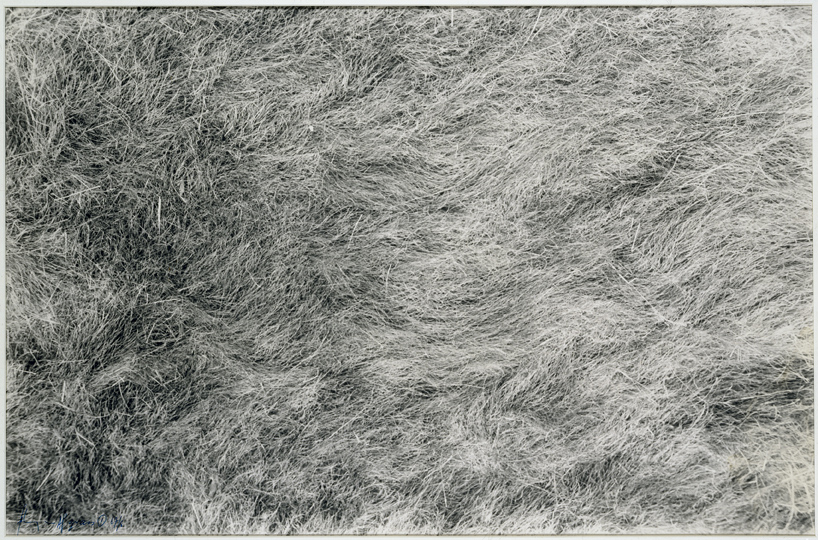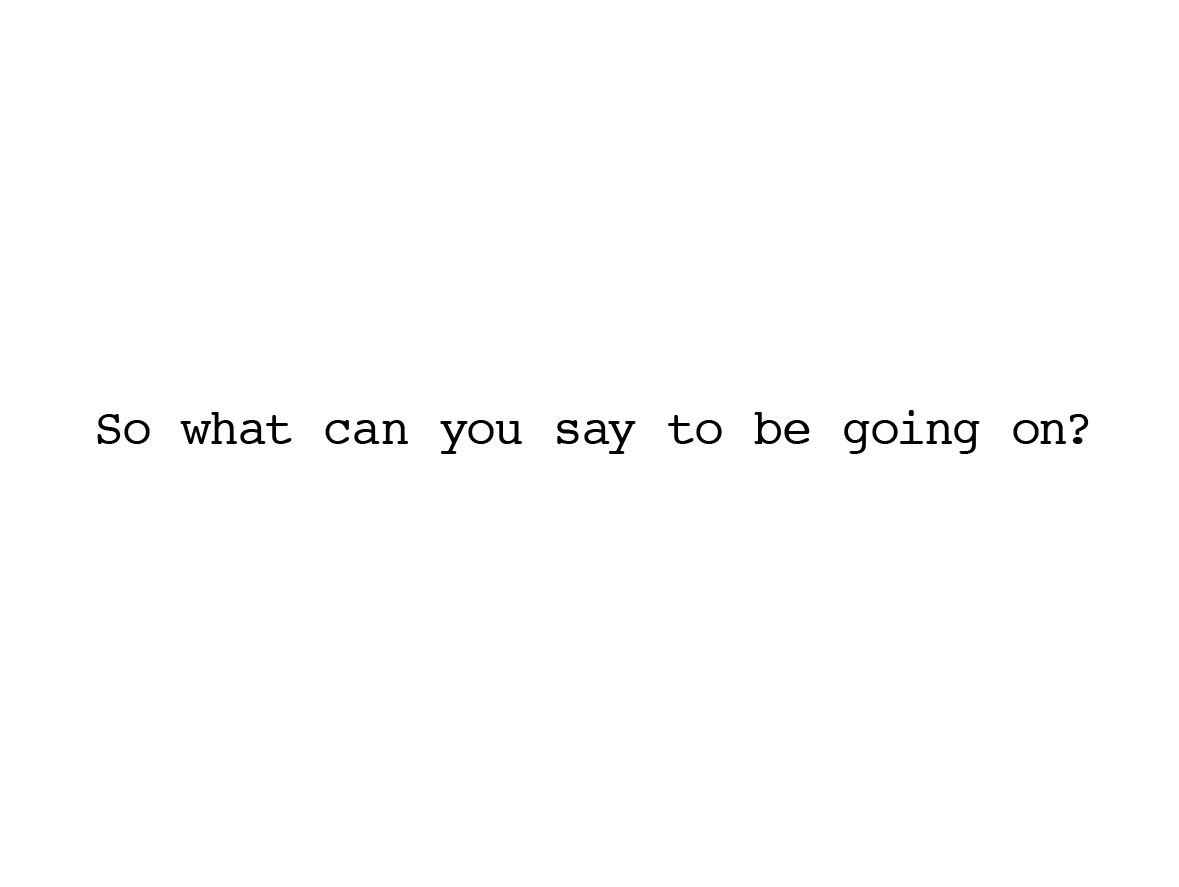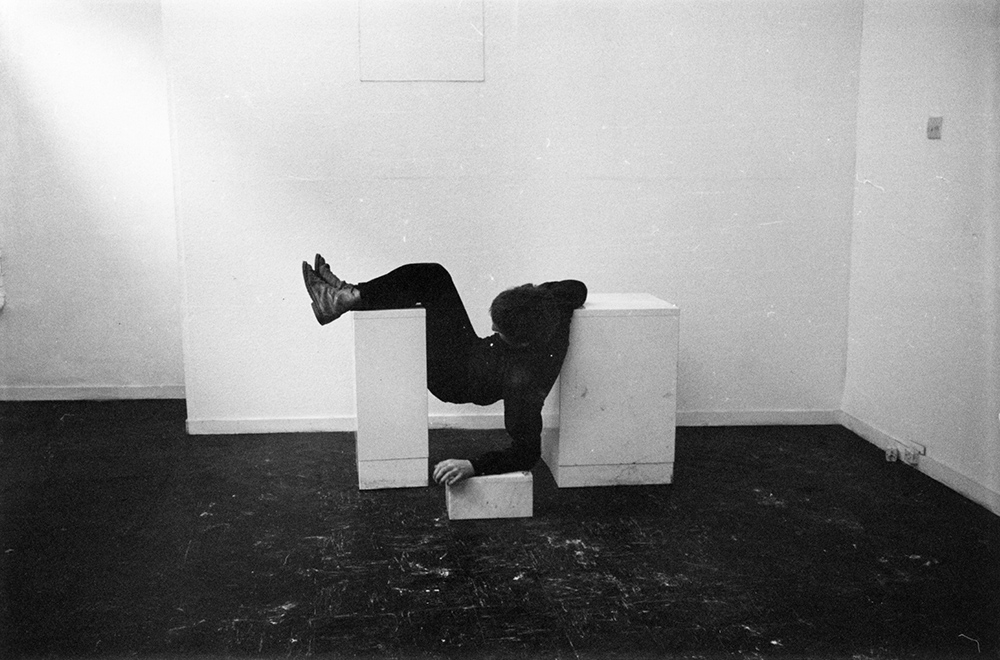INSIDE OUTSIDE SHOW
16 April–10 May 2009
Some performed sculpture made in London 1968-1974. Barry Flanagan, John Latham, Liliane Lijn, Bruce McLean, and The Locked Room compiled and edited by Garth Evans, Peter Harvey and Gareth Jones

Barry Flanagan Grass 1 (1967/8) Photograph. Courtesy Barry Flanagan.
All of the work in INSIDE OUTSIDE SHOW comes from a vital moment in the development of conceptual art in Britain, when artists were increasingly abandoning the art object and the traditional spaces for making and showing their work, in favour of event, performance, film and document.
John Latham's ideas of Event Theory and Eventstructure were central to the development of these debates and new practices. Events such as his Skoob Tower ceremonies (1963-67), and Still and Chew/Art and Culture (1966-67), as well as his and others' contributions to events such as the Destruction in Art Symposium of 1966 and the 'happenings' at Better Books during the mid-60s, can be seen as important precursors to these later widely adopted tendencies.
In all the works there are strict limitations or parameters set for the event or action; to use Latham's terminology, an 'event structure' exists. There is often an element of game-playing, puzzle or intellectual problem posed. The works also engage, sometimes inadvertently, with the inherent difficulties of preserving or documenting these new, transient practices.

Text from John Latham Sculpture of the First Second of the Year 1973 (1973) Corridor, curtains and text.
John Latham's Sculpture of the First Second of the Year 1973 is reconstructed for the exhibition. The work was included in John's exhibition at Gallery House on Exhibition Road, South Kensington in 1973 (the exhibition was part of Rosetta Brooks' important year-long series of solo exhibitions 'A Survey of the Avant-Garde in Britain'). It is a corridor piece, divided into twelve sections. In each section the viewer is asked two questions, 'so what can you say to be going on?' and 'so what can you say to have gone on?'. Responses become increasingly layered, located within and restricted by the architecture of the corridor, until light begins to seep in as the viewer approaches the final stretch, and the frame of reference is once again thrown wide open from the local to the universal.
The Locked Room (1972) shows a re-enactment by staff and students of the first days of the A Course at St Martin's School of Art. The A Course ran from 1969 - 73 and was taught by Garth Evans, Gareth Jones, Peter Harvey and Peter Kardia (then Atkins). The re-enactment was made for a BBC production entitled 'A Question of Feeling' directed by Christopher Burstall, but the film shown here is made up of footage not shown in the programme, which was later edited and compiled by Evans, Jones and Harvey. During the initial 'Materials Project' each student was given identical materials, there was to be no talking between students and no feedback or direction from staff. Students occupied the room with their materials and tools from 9.30 - 4.30 every day. Later projects introduced controlled periods of inactivity, unannounced periods when students were directed into formal discussion of their work, and short periods of collaboration. The A Course was radical in the fact that students did not receive guidance, direction or assessment from tutors and were in effect self-led, despite the strict restrictions placed upon them by space, time and materials.


Bruce McLean Pose Work for Plinths (1970) Photograph. Courtesy the artist.
Bruce McLean's Pose Work for Plinths, 1970, was originally a performance at the Situation Gallery, London. McLean performed the work again shortly afterwards for this series of photographs. Suited and booted, McLean's ridiculous leanings, drapings and manoeuvrings on a set of plinths loaned from the Tate Gallery, parody the formal plinth-based sculpture of Henry Moore.


Liliane Lijn The Power Game (1974) Courtesy the artist and Riflemaker Gallery.
Liliane Lijn's Power Game (made with Alistair Mackintosh and Great Georges Project) documents a gambling game devised as a farce on the absurdity of power. Invited guests play with a deck of cards printed with arbitrary words, which they are asked to place in a hierarchy. The guests, instructed to dress for power, are too placed in a hierarchy based on proximity to the gaming table and their financial position in the game. The commentary was added later by Lijn and Mackintosh who analyse the behaviours and reactions of the players in response to power or a lack of it. In order to enter the gaming room and participate in the game, guests had to be willing to lay money down. Guests who did not wish to do so took the position of outside observers, watching the activity via cctv footage in the next room. The Power Game was presented at the Royal College of Art in 1974 as part of the Festival for Chilean Resistance (organised by Artists for Democracy, led by David Medalla, Guy Brett, Cecilia Vicuna and John Dugger).
The artists in INSIDE OUTSIDE SHOW and the associated screenings are related through the themes within their works as well as through their associations with Latham; either through his teaching work at St Martins School of Art (Barry Flanagan, Bruce McLean and Garth Evans were students, Flanagan and Evans later tutors), and the Artist Placement Group (Barry Flanagan, Garth Evans and Liliane Lijn were all members in the early stages of APG).